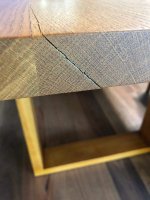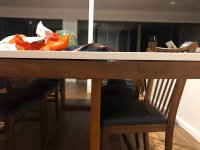Hi,
My friend is seeking general advice as he purchased a solid timber American Oak custom table top with an oil/wax finish and after only a few months he sees some problems developing.
1) cupping / bowing of the top as a whole - in the below photo where a straight/level board has been put on top you can see a gap where the table seems to have bowed/cupped quite a bit
View attachment 1
2) Crack in a single board - the photo above shows a crack which has developed in the grain, and below is a close up.
Cracked Grain.jpg
View attachment 2
3) Crack along join line - a crack in the join line between boards to make the panel has developed
Cracked Join.jpg
View attachment 3
The manufactuerer's response was to quote from their maintenance page:
"All the timber we use in our furniture is pre seasoned and ready for a long hard life. Splits andcracks may develop as it responds to the environment and these are not to be considered afault or flaw and will not compromise the construction of any furniture we make."
I am not an experienced woodworker but thought that issues 1 & 2 might be symptomatic of not letting the wood stabilise or dry out prior to creating the tabletop panel, and that issue 3 should not really happen if glued well in the first place.
I was hoping for some of your experience whether these types of problems would be typically expected and/or acceptable in a commercial product made from this material? For me it seems strange that tables that are decades (or even centuries) old can remain straight and crack free, whereas this is only months old.
Thanks in advance for your help.
My friend is seeking general advice as he purchased a solid timber American Oak custom table top with an oil/wax finish and after only a few months he sees some problems developing.
1) cupping / bowing of the top as a whole - in the below photo where a straight/level board has been put on top you can see a gap where the table seems to have bowed/cupped quite a bit
View attachment 1
2) Crack in a single board - the photo above shows a crack which has developed in the grain, and below is a close up.
Cracked Grain.jpg
View attachment 2
3) Crack along join line - a crack in the join line between boards to make the panel has developed
Cracked Join.jpg
View attachment 3
The manufactuerer's response was to quote from their maintenance page:
"All the timber we use in our furniture is pre seasoned and ready for a long hard life. Splits andcracks may develop as it responds to the environment and these are not to be considered afault or flaw and will not compromise the construction of any furniture we make."
I am not an experienced woodworker but thought that issues 1 & 2 might be symptomatic of not letting the wood stabilise or dry out prior to creating the tabletop panel, and that issue 3 should not really happen if glued well in the first place.
I was hoping for some of your experience whether these types of problems would be typically expected and/or acceptable in a commercial product made from this material? For me it seems strange that tables that are decades (or even centuries) old can remain straight and crack free, whereas this is only months old.
Thanks in advance for your help.



